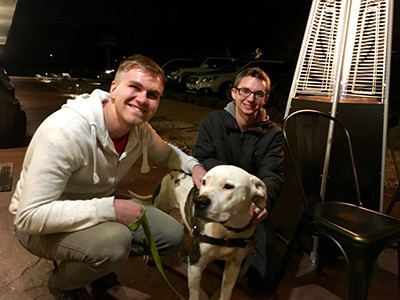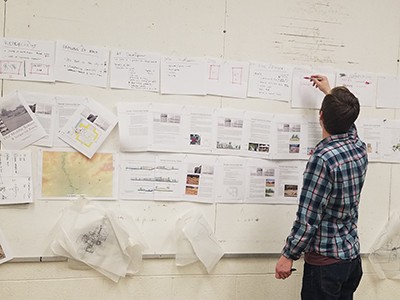USU LAEP Students and Faculty Work to Improve Animal Shelter
Landscape Architecture and Environment Planning students pose with one of the many animals that call the Best Friends Animal Sanctuary their home.
Best Friends Animal Sanctuary – a no-kill sanctuary that routinely houses an average of 1,300 creatures ranging from dogs and cats to horses and rabbits – in southern Utah is an important employer of people in nearby Kanab. It receives visitors and volunteers, those coming to adopt animals and those who arrive for a visit to the unique facility that is set amid scenic red rock and rangeland. But Best Friends is not without challenges.
This academic year, the sanctuary and city of Kanab are the subjects of the Utah State University Department of Landscape Architecture and Environmental Planning’s annual capstone project that brings the talents and creativity of every one of its student and faculty members to study a community’s challenges, opportunities and offer planning recommendations. The department, divided into 10 teams assigned to address specific issues like environmental concerns, traffic flow and economic development opportunities, made its first presentations to representatives of Best Friends on February 3.
Following site visits, online meetings with people in the area and countless hours of analyzing information about the landscape, human and animal needs, budget constraints and the local economy, the students presented ideas to more closely connect the city and sanctuary and help manage the community’s growth.
Best Friends owns 3,700 acres and leases an additional 17,000 acres. Students proposed designs for additional and sustainable housing on-site for sanctuary employees, signs to help guests feel welcome and find their way around, new water management systems and visitor picnic areas. One team, tasked with environmental assessment, also suggested that the sizable amount of animal waste produced at the sanctuary be composted for fertilizer and sold to create a new revenue source. Plans also took into account wildlife in the area and creating more habitat for the Kanab Amber Snail which is a protected species as part of overall plans for the sanctuary.
Teams studying smart development for Kanab based on current residents’ desires for smart growth, proposed areas of ranchettes of just a few acres that would attract people who value their rural lifestyle, but no longer want the demands of a full-scale farm or ranch. Such neighborhoods could include spaces for large gardens and barns and include riding trails that could connect various areas of the city and all the way to Best Friends, making Kanab an equine destination in beautiful red rock country that has capitalized on its history as a filming location for many westerns and other movies.
Kanab is situated near several national parks and monuments, but often becomes just a place for tourists to pass through. Students proposed adjusting traffic flow with new landscape design and creating more inviting, walkable areas downtown, including a new plaza near a proposed civic center that could encourage tourists to stay in Kanab a little longer and patronize local businesses. Paths to accommodate cycling were also recommended as an asset for residents and tourists.
Capitalizing on the connection between Best Friends and the city, and based on growing numbers of tourists who travel with their pets, students also recommended creating a truly pet friendly atmosphere in Kanab with the creation of dog parks that would serve residents and visitors.
Students also recommended that part of enhancing the area’s existing economic link to Best Friends, which is one of the area’s largest employers, could include the creation of a veterinary technician program at USU’s Kanab Campus.
The annual capstone project is a major undertaking in the department and benefits communities, but is foremost an outstanding learning experience for students. Teams worked countless hours in the week prior to the presentation…a necessity and tradition.
“Group projects are always a challenge, but we learn so much when we discover our different strengths and how they complement others on the team,” said Ashley Casperson. “We have to work out compromises just like we would on jobs at a design firm. It’s also a great chance for seniors to lead and teach other students because they’ve been through this before and know a lot about what we need to do.”
Ideas from the first round of presentations will be refined and formally shared with more members of the community and Best Friends’ staff. Francis Battista, Best Friends co-founder, briefly spoke to students following the 10 team presentations.
“Wow, just mind blowing!” Battista began, “You brought such energy to these ideas and this is a wonderful basis for us to move forward, especially with the things we can do ourselves.”
Battista was enthusiastic about improving connections between Best Friends and the community. He noted that though people at the sanctuary and in Kanab sometimes seem to live in parallel worlds that rarely intersect, some proposals the students developed would help create an opening in “the veil” and bring people together to build new relationships and greater prosperity.
Writer: Lynnette Harris Lynnette.harris@usu.edu
Contact: Sean Michael sean.michael@usu.edu
The Best Friends Animal Sanctuary in Kanab covers thousands of acres.
The LAEP students and faculty members spent many long hours creating plans to improve the sanctuary.
TOPICS
Hands-on Learning 211stories Land Management 124stories Landscapes 51stories Creativity 9storiesComments and questions regarding this article may be directed to the contact person listed on this page.










